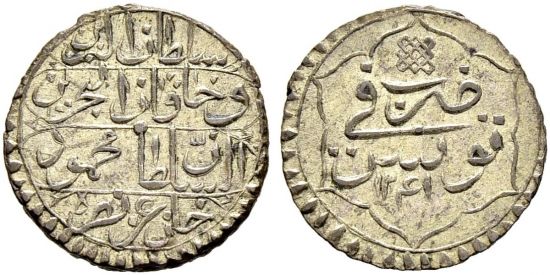Tunisia AH 1241 4 kharub
This specimen was lot 76 in Sincona sale 31 (Zurich, October 2016), where it sold for 275 CHF (about US$327 including buyer's fees). The catalog description[1] noted, "OTTOMAN TUNIS | Mahmud II (1223-1255ah/1808-1839ce) 4 kharub 1241ah (1825ce) Bi RR -unc." Tunisia, nominally subject to the Ottoman empire since the sixteenth century, survived on piracy. This eventually became unacceptable to the seafaring powers, who quashed the pirates in the 1820's. The ruling beys, deprived of revenue, attempted to reform the state but only succeeded in incurring a large foreign debt. Bankruptcy was declared in 1869 and was used in 1881 as the pretext for French occupation. This type was struck AH 1240-1255 in the name of Mahmud II in Constantinople. It is scarce in nice condition. Four kharub made a quarter piastre or riyal, the largest silver coin issued in Tunisia in the eighteenth century.
Recorded mintage: unknown.
Specifications: billon, 2.5 g, 20 mm diameter, this specimen 2.86 g.
Catalog reference: KM 88.
- Michael, Thomas, and Tracy L. Schmidt, Standard Catalog of World Coins, 1801-1900, 9th ed., Iola, WI: Krause Publications, 2019.
- [1]Jürg Richter and Ralph W. Miller, Tunisian Coins and Medals: The Miller Collection, Auction 31, Zürich: Sincona AG, 2016.
Link to:
